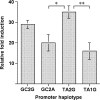Polymorphism in the PER3 promoter associates with diurnal preference and delayed sleep phase disorder
- PMID: 20469812
- PMCID: PMC2864885
- DOI: 10.1093/sleep/33.5.695
Polymorphism in the PER3 promoter associates with diurnal preference and delayed sleep phase disorder
Abstract
Study objectives: To screen the PER3 promoter for polymorphisms and investigate the phenotypic associations of these polymorphisms with diurnal preference, delayed sleep phase disorder/syndrome (DSPD/DSPS), and their effects on reporter gene expression.
Design: Interspecific comparison was used to define the approximate extent of the PER3 promoter as the region between the transcriptional start site and nucleotide position -874. This region was screened in DNA pools using PCR and direct sequencing, which was also used to screen DNA from individual participants. The different promoter alleles were cloned into a luciferase expression vector and a deletion library created. Promoter activation was measured by chemiluminescence.
Setting: N/A.
Patients or participants: DNA samples were obtained from volunteers with defined diurnal preference (3 x 80, selected from a pool of 1,590), and DSPD patients (n=23).
Interventions: N/A.
Measurements and results: We verified three single nucleotide polymorphisms (G -320T, C -319A, G -294A), and found a novel variable number tandem repeat (VNTR) polymorphism (-318 1/2 VNTR). The -320T and -319A alleles occurred more frequently in DSPD compared to morning (P = 0.042 for each) or evening types (P = 0.006 and 0.033). The allele combination TA2G was more prevalent in DSPD compared to morning (P 0.033) or evening types (P = 0.002). Luciferase expression driven by the TA2G combination was greater than for the more common GC2A (P < 0.05) and the rarer TA1G (P < 0.001) combinations. Deletion reporter constructs identified two enhancer regions (-703 to -605, and -283 to -80).
Conclusions: Polymorphisms in the PER3 promoter could affect its expression, leading to potential differences in the observed functions of PER3.
Figures




Similar articles
-
Screening of clock gene polymorphisms demonstrates association of a PER3 polymorphism with morningness-eveningness preference and circadian rhythm sleep disorder.Sci Rep. 2014 Sep 9;4:6309. doi: 10.1038/srep06309. Sci Rep. 2014. PMID: 25201053 Free PMC article.
-
Association study of a variable-number tandem repeat polymorphism in the clock gene PERIOD3 and chronotype in Norwegian university students.Chronobiol Int. 2011 Nov;28(9):764-70. doi: 10.3109/07420528.2011.607375. Epub 2011 Sep 15. Chronobiol Int. 2011. PMID: 21919721
-
A length polymorphism in the circadian clock gene Per3 is linked to delayed sleep phase syndrome and extreme diurnal preference.Sleep. 2003 Jun 15;26(4):413-5. doi: 10.1093/sleep/26.4.413. Sleep. 2003. PMID: 12841365
-
PERIOD3, circadian phenotypes, and sleep homeostasis.Sleep Med Rev. 2010 Jun;14(3):151-60. doi: 10.1016/j.smrv.2009.07.002. Epub 2009 Aug 29. Sleep Med Rev. 2010. PMID: 19716732 Review.
-
Phenotyping of PER3 variants reveals widespread effects on circadian preference, sleep regulation, and health.Sleep Med Rev. 2018 Aug;40:109-126. doi: 10.1016/j.smrv.2017.10.008. Epub 2017 Nov 6. Sleep Med Rev. 2018. PMID: 29248294 Review.
Cited by
-
Assessment of circadian rhythms in humans: comparison of real-time fibroblast reporter imaging with plasma melatonin.FASEB J. 2012 Jun;26(6):2414-23. doi: 10.1096/fj.11-201699. Epub 2012 Feb 27. FASEB J. 2012. PMID: 22371527 Free PMC article.
-
Clock 3111 T/C and Period3 VNTR gene polymorphisms and proteins, and melatonin levels in women with infertility.J Assist Reprod Genet. 2023 May;40(5):1109-1116. doi: 10.1007/s10815-023-02756-5. Epub 2023 Feb 27. J Assist Reprod Genet. 2023. PMID: 36847953 Free PMC article.
-
Clock genes and sleep.Pflugers Arch. 2012 Jan;463(1):3-14. doi: 10.1007/s00424-011-1003-9. Epub 2011 Aug 11. Pflugers Arch. 2012. PMID: 21833490 Review.
-
Delayed sleep phase syndrome is related to seasonal affective disorder.J Affect Disord. 2011 Oct;133(3):573-9. doi: 10.1016/j.jad.2011.04.046. Epub 2011 May 20. J Affect Disord. 2011. PMID: 21601293 Free PMC article.
-
Demographic history and adaptation account for clock gene diversity in humans.Heredity (Edinb). 2016 Sep;117(3):165-72. doi: 10.1038/hdy.2016.39. Epub 2016 Jun 15. Heredity (Edinb). 2016. PMID: 27301334 Free PMC article.
References
-
- Borbely AA. A two process model of sleep regulation. Hum Neurobiol. 1982;1:195–204. - PubMed
-
- Reppert SM, Weaver DR. Coordination of circadian timing in mammals. Nature. 2002;418:935–41. - PubMed
-
- Walton KM, Fisher K, Rubitski D, et al. Selective inhibition of casein kinase 1 epsilon minimally alters circadian clock period. J Pharmacol Exp Ther. 2009;330:430–9. - PubMed
-
- Franken P, Dijk DJ. Circadian clock genes and sleep homeostasis. Eur J Neurosci. 2009;29:1820–9. - PubMed
Publication types
MeSH terms
Substances
Grants and funding
LinkOut - more resources
Full Text Sources
Medical

